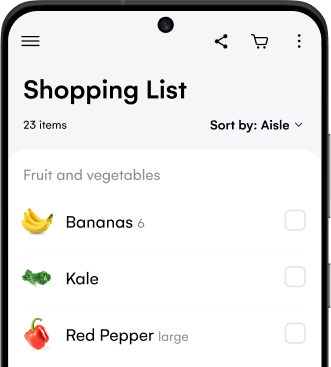Ever wonder: what does sugar free actually mean? An increasing number of health-conscious consumers are seeking alternatives to sugar; such as honey, applesauce, and stevia. But are sugar free alternatives really healthier? And how do you know if sugar-free is code for ‘extra fat and flavorings’ or really is a good option? The clues are in the labels!
Sugar labels pose a challenge for many people. You’ll often see labels like reduced sugar, low sugar, unsweetened, no added sugar, sugar-free, and zero sugar on food packaging. So, in this article, we’ll look at these labels, and debunk any myths around what they really mean. We hope it’ll help you to make informed choices when it comes to sugar, and navigate shopping aisles with confidence!
Analyse nutritional information for any recipe

Reduced Sugar
Reduced sugar indicates that the product contains at least 25% less sugar compared to similar products. To achieve this status, manufacturers often employ sugar substitutes or alternative sweeteners.
These can include artificial sweeteners like aspartame, sucralose, or natural sweeteners like stevia.
Since sugar is a significant source of calories, products with a “Reduced Sugar” claim may contribute fewer calories. However, they may still contain significant sugar content. It’s key to check the nutrition label to see the exact reduction percentage and the remaining sugar content. Also, consider the recommended serving size on the label.
Low Sugar

Ever see low sugar written on labels or products? And thought they were the healthier alternatives?
These kind of labels need to approached with care! Low sugar suggests that a product contains a small amount of sugar in comparison to similar or standard versions of the product.
However, many regions have their own standard of low sugar – or none at all. For example, the European Union defines what low sugar means. In comparison, the FDA (U.S. Food and Drug Administration) doesn’t have a specific legal definition of low sugar.
Low sugar products can help reduce sugar intake when eaten in moderation. But consider their overall nutritional profile and your regional definitions to make informed choices about what you eat.
Unsweetened
Unsweetened suggests there are no sugars or sweeteners in a product. However, this doesn’t mean that it doesn’t have naturally occurring sugars! Honey is unsweetened, for instance!
These products often taste less sweet in comparison to sweetened alternatives. Unsweetened foods can be good choices for those hoping to reduce their sugar and calorie intake.
You’ll find unsweetened sugars in products like almond milk, yogurt, or applesauce. This can be particularly relevant for those managing conditions like diabetes and/or those following low-sugar diets or keto diets. Remember though, always check for added sugars or artificial sweeteners.
No Added Sugar

No added sugar suggests that no additional sugars or sweeteners were added to your foods.
As we’re learning, this label doesn’t guarantee anything. It may contain naturally occurring sugars from ingredients like fruit.
These products might be appealing if you’re looking to limit their sugar intake. However, it’s essential to check the Total Sugars content on the nutrition label. This section tells us about the added and naturally occurring sugars. We’d also recommend checking the ingredient list and nutrition label to identify the source of any sugars.
Sugar Free

Sugar-free means that a product contains less than 0.5 grams of sugar per serving. Foods and beverages with this label are intentionally formulated to be sugar-free.
Who enjoys them? People who want to limit their sugar intake without compromising on a sweet taste.
They can also be used to reduce overall sugar consumption. But sugar-free foods often use substitutes or artificial sweeteners like aspartame, sucralose, or stevia to maintain sweetness.
They might taste slightly different compared to those containing sugar. So, once again, check out the ingredient list to identify any sugar substitutes or sweeteners!
Zero Sugar

Zero sugar indicates that the product contains no sugar or any sugar-based ingredients. However, that product might still include sugar substitutes like artificial sweeteners.
These sugar products are suitable for those who want to completely eliminate sugar from their diets or reduce calorie intake. You’ll commonly find them in zero sugar gum, sodas, and candies. Be aware. Zero sugar products often rely on artificial sweeteners, which have their own set of health considerations. We’re not saying you shouldn’t eat them – but you should know what the trade off is!
So What Are the Differences?
Now that we’ve gone over some of the meanings of sugar labels, let’s check out the differences between them.
Zero Sugar vs Sugar Free
| Zero Sugar | Sugar Free | |
| Sugar content | 0 grams of sugar per serving. | Contains less than 0.5 grams of sugar per serving. |
| Sweeteners | May contain natural sweeteners or artificial sweeteners. | Typically involves the use of artificial sweeteners like sucralose, aspartame, or stevia. |
| Dietary goals | Ideal for those aiming to eliminate sugar entirely or reduce calorie intake. | Suitable for people managing conditions like diabetes or looking to reduce overall sugar intake. |
| Taste | May use natural sweeteners or have a less sweet taste. | Often designed to mimic the taste of sugar, providing sweetness without calories. |
| Calories | Generally lower in calories, especially if natural sweeteners are used. | Lower in calories due to the use of artificial sweeteners. |
| Considerations | May be a preference for those looking for a more natural option. | Suited for those with specific dietary needs or those looking to enjoy sweet treats with reduced sugar impact. |
Unsweetened vs No Added Sugar
| Unsweetened | No Added Sugar | |
| Sugar content | Indicates the absence of added sugars or sweeteners during processing. However, natural sugars from ingredients like fruit may still be present. | Natural sugars from ingredients like fruit may be present, but no extra sugars are added. |
| Sweeteners | Does not contain added sweeteners. | Does not contain added sugars or sweeteners. |
| Dietary goals | Ideal for those looking to minimize added sugars in their diet. | Useful for those wanting sweetness without extra sugar. And suitable for people managing sugar intake. |
| Taste | May have a less sweet taste compared to sweetened counterparts. | Provides sweetness without additional sugars, maintaining a more natural taste. |
| Calories | Generally lower in calories compared to sweetened versions. | May be lower in calories compared to products with added sugars. |
| Considerations | Ideal for those looking to reduce sugar intake while enjoying the inherent flavors of natural ingredients. | Suited for those who want sweetness without the extra sugars, potentially for dietary or health reasons. |
FAQs
Look at the nutrition label and check the “Total Sugars” section. Products with lower sugar content will have fewer grams of sugar per serving. A good rule of thumb is that 5g or less of total sugars per 100g is considered low sugar.
Common artificial sweeteners include aspartame, saccharin, sucralose, acesulfame potassium (Ace-K), and steviol glycosides (from the stevia plant). The specific sweetener used will be listed in the ingredients.
While natural sweeteners may offer some minor nutritional benefits, they are still high in sugar and should be consumed in moderation. They can also affect blood sugar levels.
Focus on whole, unprocessed foods, and read nutrition labels carefully. Pay attention to portion sizes and choose products with lower sugar content. Be mindful of the overall nutritional profile of the food.
Artificial sweeteners are sugar substitutes used to sweeten foods and drinks without the added calories of sugar. The safety of artificial sweeteners is a subject of ongoing research. Many are considered safe when consumed within established acceptable daily intake levels.
Consuming more than 10% of your daily calories from added sugars is often considered excessive. For adults, this equates to roughly 50 grams or 12 teaspoons of added sugars per day.
Conclusion
Decoding sugar claims is an essential skill for anyone looking to make healthier dietary choices! You almost need to be like detective, but it’s essential for making more informed dietary choices. Always read the ingredient list and nutrition label to get an idea of what’s in your food.
If you would like to read more about sugar alternatives, read our blog ‘Top 20 Healthy Sugar Substitutes for Baking‘. It’ll also give you an idea of what sugar alternatives can use for day-to-day cooking!
Get inspired and connect with other home cooks like you

